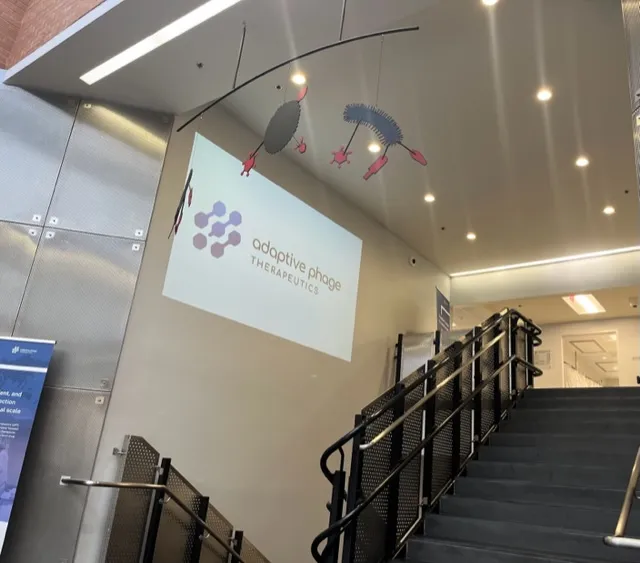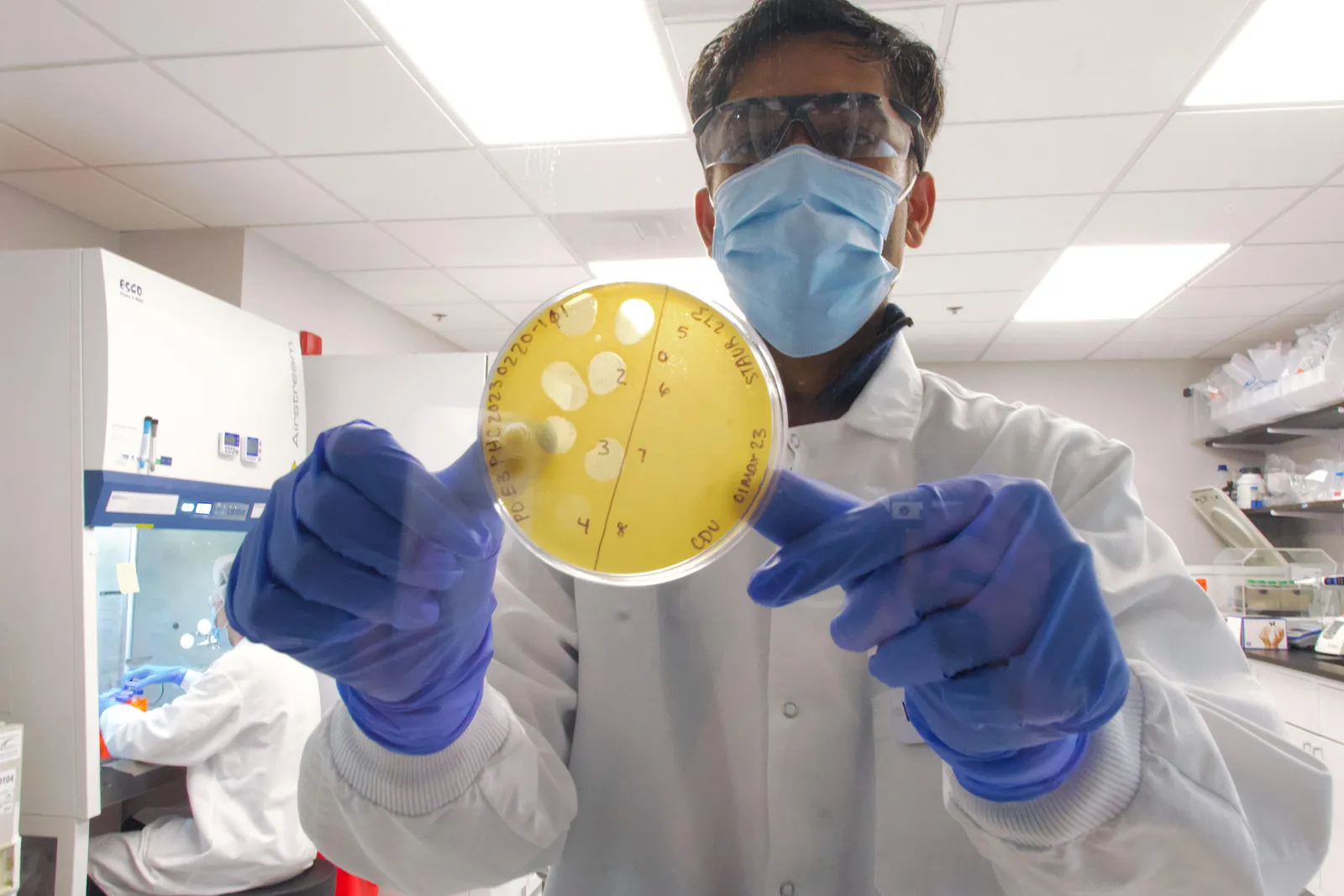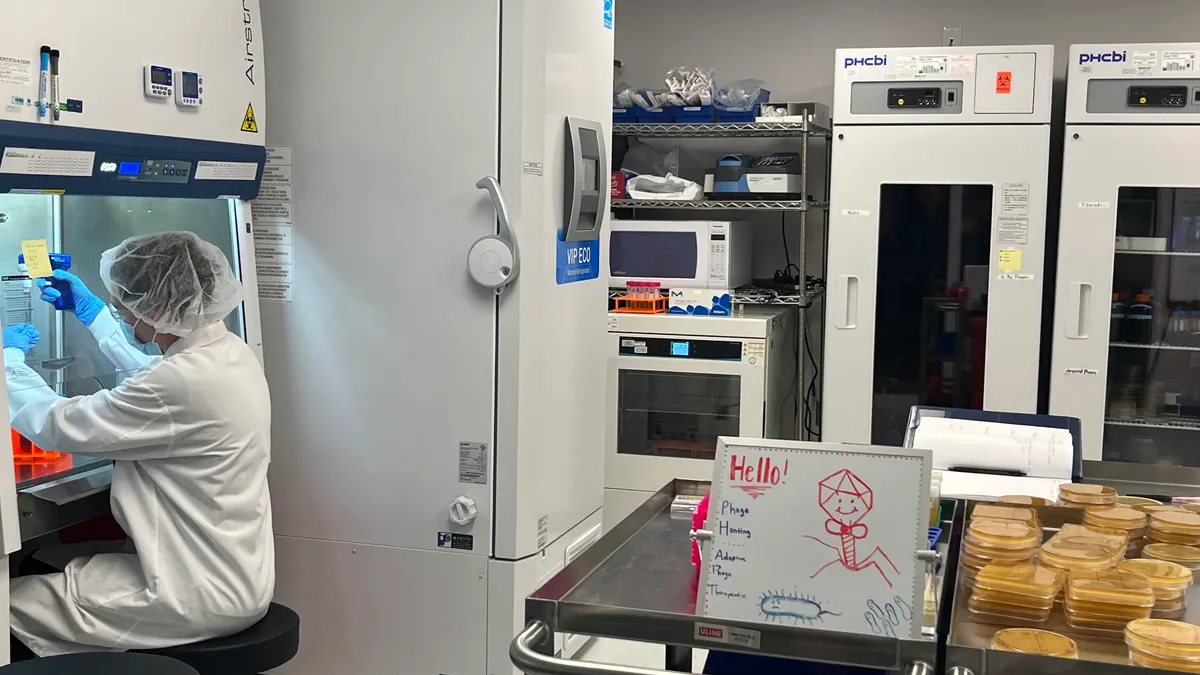By all accounts, Tom Patterson was going to die.
The ancient bacteria Acinetobacter baumannii had infiltrated Patterson’s body while he was on vacation in Egypt and quickly spread through his bloodstream. To make matters worse, the infection was resistant to almost all antibiotics.
With little hope, Steffanie Strathdee, Tom’s wife and an infectious disease epidemiologist, turned to a fledgling area of science emerging out of government research labs — phage therapy. That was in 2016.
Patterson soon became the first of dozens of patients whose antimicrobial-resistant (AMR) infections were cleared through compassionate use of the technology, which is being tested for commercial drug development by the Maryland-based Adaptive Phage Therapeutics.
The company, founded by a father-son duo based on the research first developed in labs at the NIH and Department of Defense (DoD), is one of several turning to phages — short for bacteriophages, Greek for “bacteria eater” — as a tool in the fight against so-called superbugs, which killed an estimated 1.7 million people globally in 2019 and are expected to affect as many as 10 million people annually by 2050.
As challenging funding dynamics continue to stunt the development of needed antibiotics, and with little government intervention, phages are gaining steam as a potentially more accurate weapon to combat these multi-drug resistant infections. Companies are taking a variety of approaches to develop them, from engineering phages with CRISPR to packaging several strains of phages together as a cocktail, and, in Adaptive’s case, using natural phages.
So far, results from compassionate use cases like Patterson’s have shown promise, but clinical results are still needed to validate the approach and improve funding dynamics, said Henry Skinner, CEO of the public-private investment partnership AMR Action Fund, which invested in Adaptive Phage last year.
“We certainly have good anecdotal data — so not necessarily the full set of data that you'd like to see from a clinical study, but good anecdotal data,” he said.
A long time coming
Strewn on most of the walls of Adaptive’s office and lab space, just down the road from the NIH in Rockville, Maryland, are images of endearingly googly-eyed and smiling phages that make the parasitic viruses appear harmless. And for the most part, they are to humans. But don’t be fooled — they’re also bacteria’s No. 1 natural predator, and a vicious one at that.

The viruses, which outnumber grains of sand on earth, are highly targeted so, unlike antibiotics that broadly stop infections, they won’t harm human or ‘good’ bacteria cells. Of course, the downside of that is they need to be precision tailored to work, and that’s largely why they’ve never taken off as a therapy, Greg Merril, CEO of Adaptive Phage said.
In the early 20th century, when phage research was getting off the ground, scientists sought to overcome the problem by combining phage strains into “cocktails” that they believed might create a broader spectrum treatment against bacteria. Then, the discovery of penicillin as an antibiotic pushed phages to the side.
In the 1960s, when Dr. Carl Merril, Greg's father, began investigating phages as a government researcher, people thought he was crazy.
“His lab was on the campus of NIH in Bethesda and was in the same building as the Clinical Center,” Greg Merril said. “They had an outbreak of a bacterial infection that was hospital-acquired, and patients were dying. No antibiotics were working and my father's lab was there and he was working on these phages. So he was like, ‘Why don't we use the phage to treat these patients?’”
They didn’t end up following the elder Merril’s lead at the time, but cut to half a century later when soldiers began returning from Iraq with antibiotic-resistant infections — the DoD came knocking and the research finally gained acceptance. Later, when it worked to cure Patterson and a 2-year-old baby with a resistant Pseudomonas infection, it started turning heads.
“At that point, the (Biological Defense Directorate) went to the big pharmaceutical companies that had antibiotics and said, ‘We've got this approach that can cure people (who) can't be cured by your antibiotics. Are you interested in taking this and running with it?’” the younger Merril said. “And the pharmaceutical company said, ‘Not only are we not interested in that, but we don't even want the antibiotics because we're losing money on antibiotics.’”
That’s when he jumped on board, teamed up with his dad, acquired the rights to the phage program from the DoD, and began a run at developing a solution to AMR.
A new approach
Unlike phage therapy attempts of the past, Adaptive is leaning into the viruses’ narrow applicability with a proprietary “phage bank.”
First, a “phage hunting team” collects environmental samples from places like the Baltimore Zoo, wastewater treatment facilities and farms where phages are rampant. Then, the team exposes a petri dish of a type of bacteria to the environmental sample. If anything in the environmental sample is killing the bacteria, it will create clear spots in the otherwise cloudy dish that researchers can pluck out, grow as a phage and add to the bank.

“Bacteria is going to become resistant to the phage. And as that's happening, we're just adding new phage that will kill the bacteria that's resistant to the other phage so over time, our spectrum of coverage never goes down, it actually goes up,” Merril explained.
The bank and the therapies that come about as a result are regulated in the same way that annual vaccines like the flu shot require upgrades from time to time.
“Our proposal to the FDA was that you have to have a product that can adapt to emerging resistance. That's why we call the company Adaptive,” he said. “During the clinical trial, if a phage works initially, but then the bacteria become resistant, or if we’re finding the patient’s bacteria doesn’t match the phage, we just bring in a different phage.”
The company is currently in phase 1/2 trials to treat conditions including diabetic foot osteomyelitis, prosthetic joint infection and cystic fibrosis-related lung infection. These types of chronic conditions, where patients might be suffering from an infection for a week or longer, are the sweet spot for Adaptive Phage’s approach, Merril said. And the company knows its shortcomings, as well.
“If you have something like acute pneumonia, where you need to get something right away, this approach isn't so good for that,” he affirmed.
While still early in clinical development, Merril said insights like this gained from almost 50 compassionate use cases of the company’s technology have informed use cases and study design.
“We come into our clinical trials with this belief because of our observation of these emergency cases that phage works,” he said. “For us, it's more like if we are not successful with clinical trials, we failed the drug, it wasn't like the drug failed.”
Funding landscape
Even with these early results, the path to approval isn’t certain. Despite differences between phages and antibiotics, and Adaptive’s platform to outrun resistance, the therapy still faces similar valuation and investment challenges.
“The investors initially just want to paint us with the same brush as antibiotics,” Merril said.
Much of the company’s funding so far has come from government entities like the DoD, as well as public-private partnerships and nonprofits including the AMR Action Fund. In the case of government funding, Merril said, it’s more of a down payment or “customer financing.”
"For us, it’s more like if we are not successful with clinical trials, we failed the drug, it wasn’t like the drug failed.”

Greg Merril
CEO, Adaptive Phage Therapeutics
“As long as it can get through the regulatory path and become a licensed product with the FDA, they will buy the product. They're funding these clinical trials to get to the point where they can deploy it for the military,” he said.
Down the road, if the technology approaches the point of approval, Skinner suggested that the investment dynamic for the whole space could change.
“Phage has a lot of promise. But it also in some ways is unproven. We do not have an approved phage product to say, ‘Here's how you do it. Here's the pathway,’” Skinner said. “I’d say it's not funded the way it ideally would be, like with anything new. I just don't think we have enough capital being invested.”
And Merril added that, while phage could be an integral component of tackling superbugs, antibiotics will always be necessary.
“Maybe it replaces antibiotics in the more distant future, but I don't think we need to replace antibiotics,” he said. “If the antibiotics are killing bacteria in one way, and this is killing bacteria from another angle, then the two can work together really well to be more efficient.”













